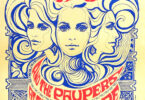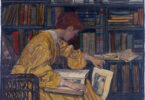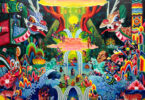
There wasn’t much downtime in the late 16th century workshop and academy of Bologna’s artistic Carracci family—Annibale, his brother Agostino, and their cousin Ludovico. They were known bythe co llective name “the Carracci.” Commissions poured in from patrons captivated by the trio’s innovative approach. To viewers accustomed to the classical restraint of Renaissance art and Mannerism’s studied elegance, the portrait-like faces and dynamic actions of the Carracci’s imagery pulsated with energy and emotion. The revolutionary style would come to be called by the French term “Baroque.” Its etymology is disputed, but the word is often associated with the Romance languages’ adjective for the endlessly varied shapes of irregular pearls.
The same inventive spirit prevailed in the Carracci’s rare recreational hours. Both for demonstration and entertainment, they led their students in drawing one another and their fellow Bolognese with comically exaggerated features. The results engendered the Italian noun caricatura (from the adjective caricato meaning loaded) which resulted in the English word caricature. The art form spread beyond Bologna and by the mid-19th century, British, French, and American magazines featured caricatures that mocked easily-recognized denizens of government, high society, and the stage.
In the 1920s and 1930s, New York City abounded with celebrities for artists to caricature, both caustically and affectionately. One such artist—Alfred J. Frueh (pronounced “free”)—honed his skills in the Carracci tradition. During downtime at the Lima (Ohio) Business College, he turned the abbreviated lines and shapes of shorthand into the faces of teachers and fellow students. This minimalist approach became the foundation of his art. In 1907, during his early years as an artist for the St. Louis Post-Dispatch, one actress was so outraged by his caricature of her that she cancelled her local operetta performance. Frueh then studied in Europe, and in 1910 joined the New York World newspaper. In 1925, he began 37 years as the New Yorker’s theatrical caricaturist.
A 1911 poster for George M. Cohan’s play The Little Millionaire featured a photograph of the standing impresario wearing a tilted hat and leaning on a cane. Frueh transformed the static image into a shorthand version of a breezy, toe-tapping Cohan, swinging his cane as he saunters by, head thrust confidently forward. Lines in motion, even lines that stop mid-air, make Cohan’s moniker “the man who owned Broadway” come alive.
Frueh included the Cohan image as a linotype print for the 1922 book Stage Folk: A Book of Caricatures. Alfred Stieglitz showed the original drawing in a 1912 exhibition at his prestigious Gallery 291, where he applauded Frueh’s “gentle if sometimes mordant irony.” The drawing is now in the National Portrait Gallery’s collection.
While Frueh imagined Cohan on an imaginary stroll, Oscar Cesare caricatured Broadway star Jeanne Eagels in a live 1927 performance. Reviews complimented her comedic agility in the French farce Her Cardboard Lover when she “all but disrobes to the skin at one point… at (her) bedside telephone.” Cesare portrays Eagels’s nimble one-handed change of clothes amid a swirl of curves and decorative flourishes. His lines magnify the distinctive jawline, upturned nose, and angular physique evident in photographs of the actress. The cloud-like foreground suggests the spirit of the play—often described as “frothy.” Although Eagels is less famous today, her stage and early-film appearances won many fans. According to the Austin Film Society, the young Barbara Stanwyck partly modeled her own acting style on the older actress.
Cesare’s work was widely recognized by the late 1920s. After his 1903 arrival in the US, the Swedish-born and Paris-trained painter, draftsman, and illustrator worked for many newspapers and magazines through the mid-1940s. A 1922 assignment for the New York Times allowed him rare access to the Kremlin, where he created drawings of Lenin and Trotsky. The portraits appeared with his text in the article “Lenin and His Moscow.” Cesare also exhibited internationally, and his work is held in several public collections.

During the Depression of the 1930s, theatrical productions on the Great White Way dropped by about half. Some plays could be seen for as little as $1 (about $18 today), but movie tickets cost about 25 cents. Although caricaturists didn’t spare Hollywood luminaries, the persistent economic crisis made politicians even more tempting subjects.
In 1934, Peggy Bacon took aim at New York’s newly elected mayor Fiorello La Guardia, and included his caricature, along with 40 others, in her book Off With Their Heads! La Guardia’s nickname, “little flower,” a translation of his first name, referenced his stature of 5’2″ but ironically belied his pugnacious personality and relentless energy. Known as a reformer of Tammany Hall corruption and a champion of civic improvements, he was often photographed in an office strewn with scattered files, documents, and books. Bacon’s lithograph reduced the papers to a small stack, the better to emphasize his rotund figure pressed against the desk. The mayor concentrates on the matter at hand, but hovers on the edge of his seat as if ready to spring up at any moment. His unshaven face, unruly hair, and cowlick suggest a public servant who works round the clock.

A native New Yorker, Bacon studied at the city’s Art Students League with leading artists John Sloan and George Bellows. She cited the caricatures of 19th century satirist Honoré Daumier as an influence, mastered a wide array of media, and illustrated over 60 books, including her own short stories and poetry. Her La Guardia image evokes the title of the exhibition at the Portland (Maine) Museum of Art: “Peggy Bacon: Biting, Never Bitter.” She believed that a caricature “should include in its extravagant appraisal whatever of the figure may be needed to explain the personality, the whole drawing imparting a spicy and clairvoyant comment upon the subject’s peculiarities.”
With incisive wit and adroit drawing, the three New York artists would have been stand-outs more than four centuries ago, if they had been working in the Carracci studio. Each exemplified Annibale’s conviction that “a good caricature, like every work of art, is more true to life than reality itself.” G&S
© Mary F. Holahan 2024
Peggy Bacon: Biting, Never Bitter (June 14, 2024—February 2, 2025). portlandmuseum.org/peggybacon
For further reading:
metmuseum.org/art/collection/search/350135
artvee.com/artist/oscar-edward-cesare





Leave a Comment